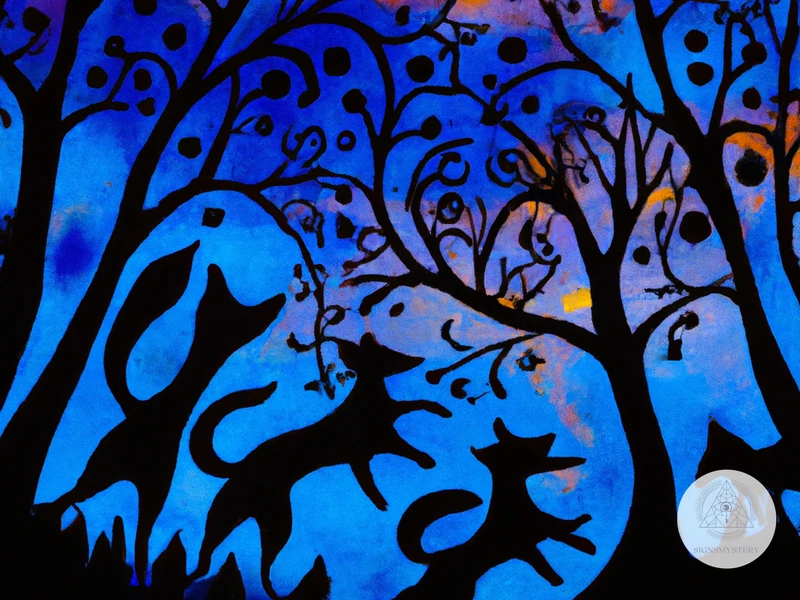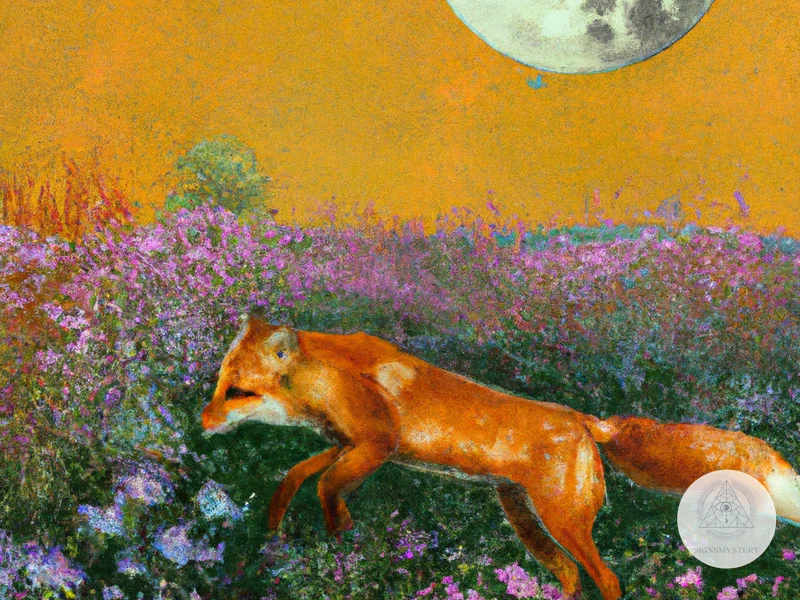Throughout history, foxes have captured the imagination and intrigue of various cultures worldwide. These cunning creatures have been woven into the fabric of folklore, legends, and myths, assuming different roles and symbolic meanings in each narrative. From being revered as symbols of wisdom and trickery to serving as messengers and spirit guides, foxes have left an indelible mark on our collective consciousness. In this article, we embark on a journey to explore the symbolic importance of foxes in folklore, delving into their portrayal as clever tricksters, their mythical incarnations in different cultures, their symbolism across various cultural and spiritual traditions, and their prominent presence in fairy tales and children’s literature. Let us embark on this fascinating exploration into the captivating world of the fox.
The Cunning Fox

The fox, often depicted as a cunning and sly creature, has long held a prominent role in folklore and mythology. Known for its cleverness and agility, the fox has become synonymous with trickery and intelligence. In many tales and fables, the fox outwits its adversaries through elaborate schemes and cunning strategies. This portrayal of the fox as a trickster is evident across cultures, where it also holds significance as a spirit animal or dream symbol. Its ability to adapt and survive in various environments further adds to its reputation as a clever survivor. Whether it is using its wit to obtain food or evade predators, the fox’s resourcefulness is a trait that has been celebrated and revered for centuries.
The Fox as a Trickster
In folklore and mythology, the fox is often portrayed as a mischievous trickster who thrives on cleverness and cunning. This cunning nature is highlighted through various tales where the fox outsmarts other animals or even humans through intricate schemes and deceptions. From Aesop’s fables to Native American folklore, the fox is a recurrent character known for its ability to manipulate situations to its advantage. The fox’s trickster archetype transcends cultural boundaries, appearing in stories from different regions around the world. In Native American mythology, the fox is revered as a clever trickster who uses its wit to navigate difficult situations and outsmart more powerful creatures. In Japanese folklore, the Kitsune, a mythical fox, is often depicted as a shape-shifter and a master of illusions, playing pranks on unsuspecting individuals. This portrayal of the fox as a trickster serves as a reminder that intelligence and resourcefulness can triumph over brute strength and power. The fox’s trickster persona also holds a deeper meaning, teaching valuable lessons about the consequences of greed, vanity, and arrogance. This multifaceted portrayal of the fox as a trickster adds depth and richness to the symbolic significance of the animal, making it an intriguing and enigmatic character in folklore and mythology. In dreams, the fox as a trickster can symbolize the need for adaptability and quick thinking, urging individuals to approach challenges in a clever and strategic manner. Additionally, the fox as a trickster may also serve as a reminder not to take things at face value and to remain vigilant against deceit and manipulation. The fox’s role as a trickster has captured the imagination of storytellers throughout history, emphasizing the power of wit and cunning in navigating the complexities of life.
The Fox as a Clever Survivor
The fox’s prowess as a clever survivor is truly remarkable. With its adaptable nature and keen intelligence, the fox has thrived in a wide range of habitats, from dense forests to urban landscapes. One of the fox’s most impressive survival strategies is its ability to camouflage itself, blending seamlessly into its surroundings. This skill allows the fox to remain hidden from potential predators and silently stalk its prey. Additionally, the fox’s agility and quick reflexes enable it to navigate through obstacles with ease, ensuring its escape from dangerous situations. Another fascinating aspect of the fox’s survival tactics is its remarkable ability to locate and store food. Foxes are known to cleverly bury excess prey or store it in hidden caches, ensuring a food reserve during leaner times. This resourcefulness has enabled the fox to adapt to a wide range of environments and thrive in challenging conditions. The fox’s exceptional hearing and keen sense of smell aid in its survival, allowing it to detect the subtlest of sounds and scents. By utilizing all of its senses and employing its strategic intelligence, the fox has proven itself to be an extraordinary survivor in the natural world. Its remarkable abilities and adaptive nature make it a truly fascinating creature to study and admire.
Mythical Foxes around the World
Mythical foxes have captured the imagination of cultures around the world, each with their own unique folklore and legends surrounding these enchanting creatures. In East Asian folklore, the nine-tailed fox takes center stage, renowned for its shape-shifting abilities and great wisdom. This mystical creature is often seen as both a harbinger of good fortune and a seductive temptress. Similarly, in Japanese folklore, the kitsune is revered as a magical fox capable of possessing humans, granting wishes, and displaying incredible intelligence. In European folklore, the Reynard holds a prominent position as a cunning trickster, often outsmarting other animals with its cleverness and wit. These mythological foxes not only serve as captivating characters in stories, but they also hold deeper symbolic meanings within their respective cultures, embodying traits such as trickery, wisdom, and power. Exploring the symbolism of these mythical foxes allows us to delve into the rich tapestry of folklore and better understand the significance they hold in these diverse cultural narratives.
The Nine-Tailed Fox in East Asian Folklore
In East Asian folklore, the Nine-Tailed Fox is a mythical creature that holds a significant place in storytelling and cultural traditions. Believed to possess immense power and wisdom, the Nine-Tailed Fox is often portrayed as a shape-shifting creature with nine tails, each representing extraordinary abilities. In Chinese mythology, it is known as the “Jiuweihu” or “Huli Jing,” while in Korean folklore, it is referred to as the “Gumiho.” This mystical fox is commonly depicted as a beautiful, seductive being with the ability to transform into various forms, often using its allure to ensnare unsuspecting humans. The Nine-Tailed Fox is renowned for its knowledge of ancient wisdom, sorcery, and divination. Legends often depict it as a powerful spirit or deity capable of bringing either blessings or misfortune to those who encounter it. In some tales, the Nine-Tailed Fox is depicted as a symbol of both good and evil, representing the duality of its nature. Its mesmerizing presence and enigmatic reputation evoke a sense of awe and fear, making it a captivating figure in East Asian folklore. Whether seen as a harbinger of wealth and prosperity or a bringer of chaos and temptation, the Nine-Tailed Fox continues to intrigue and inspire with its mythical allure.
The Kitsune in Japanese Folklore
In Japanese folklore, the Kitsune holds a special place as a mythical creature deeply rooted in the country’s cultural traditions. The Kitsune, which translates to “fox” in English, is often portrayed as a cunning and shapeshifting being with extraordinary powers. According to legends, Kitsune possess multiple tails, with each tail granting them greater wisdom and power. They are believed to possess the ability to shape-shift into human form, often appearing as beautiful women with fox-like features. Kitsune are known for their mischievous nature, playing pranks and tricking unsuspecting individuals. However, they are also considered as divine beings associated with Inari, the Shinto deity of rice and agriculture. They are often depicted as messengers of Inari, and their presence symbolizes good fortune and protection. There are different classifications of Kitsune based on the number of tails they possess, with nine-tailed Kitsune being the most revered and powerful. In Japanese folklore, the Kitsune serves as a powerful symbol of intelligence, cunningness, and spiritual significance, weaving its enchanting presence into the rich tapestry of Japanese mythology and cultural beliefs.
The Reynard in European Folklore
In European folklore, the character of Reynard the Fox has played a significant role, representing both cunning and deceit. Reynard is a popular figure in medieval literature and is often depicted as an anthropomorphic fox. The stories of Reynard the Fox originated in France and spread throughout Europe, captivating audiences with his cleverness and wit. Reynard is portrayed as a complex character, sometimes a hero, sometimes a villain, but always using his intelligence to navigate various situations.
In these tales, Reynard often finds himself in conflict with other animals, including the wolf, the bear, and the rooster. Through his cunning and trickery, he manages to outsmart and manipulate his adversaries, ultimately coming out on top. The character of Reynard serves as a symbol of both the power of wit and the potential dangers of deception.
The popularity of Reynard the Fox in European folklore also extended to other forms of art and literature, including paintings, sculptures, and even plays. Reynard’s cunning and mischievous nature made him a fascinating and enduring figure in European culture.
Symbolism of Foxes in Different Cultures

The symbolism of foxes varies greatly across different cultures, reflecting the diverse interpretations and beliefs associated with these captivating creatures. In Native American mythology, foxes are often regarded as symbols of wisdom and cunningness, embodying the ability to navigate through complex situations with agility and intelligence. Celtic lore, on the other hand, associates foxes with transformation and shape-shifting, as they are believed to possess the power to assume human form. In African folktales, foxes are often portrayed as clever messengers, carrying important information between humans and the spiritual realm. These cultural interpretations showcase the rich symbolism that foxes hold in different parts of the world.
Wisdom and Cunningness in Native American Mythology
In Native American mythology, the fox is often depicted as a symbol of both wisdom and cunningness. Many Native American tribes view the fox as a clever trickster figure, similar to the coyote or raven in other cultures. The fox is often portrayed as a shape-shifter, capable of transforming into other animals or even taking on human form. This ability to change shape allows the fox to navigate the world with cunning and intelligence, outsmarting its adversaries and finding creative solutions to challenges. The fox is also associated with adaptability, resourcefulness, and quick thinking in Native American folklore. It is seen as a messenger between the human and spirit realms, acting as a guide and teacher to those who possess a deep connection to the natural world. The tales and legends featuring the fox often carry moral lessons, emphasizing the importance of wit, strategy, and the ability to think on one’s feet. In Native American mythology, the fox embodies the dual qualities of wisdom and cunningness, serving as a powerful symbol of intelligence and adaptability within the rich tapestry of Native American folklore and spiritual traditions.
Transformation and Shape-Shifting Legends in Celtic Lore
In Celtic lore, the motif of transformation and shape-shifting is deeply ingrained in the tales that have been passed down through generations. The fox, known as “sionnach” in Gaelic, is often associated with these mystical abilities. According to Celtic mythology, certain individuals possessed the power to transform into animals, including the fox, through the practice of druidic magic or through encounters with supernatural beings. This ability to shape-shift allowed them to navigate between the human realm and the spiritual realm, bridging the gap between the mortal and the divine. The fox, in particular, was revered for its cunning and intelligence, making it a favored form for these transformative abilities.
In Celtic legends, foxes were believed to possess the wisdom and magical prowess necessary for supernatural transformations. They were believed to have access to secret knowledge and were seen as guides and messengers between the mortal world and the realm of the deities. The shape-shifting foxes were often depicted as mysterious and alluring figures, capable of leading individuals on extraordinary journeys or revealing hidden truths. These legends served as a reminder of the interconnectedness of the natural and spiritual worlds, highlighting the transformative power that can be unlocked through embracing the wisdom of the fox.
Stories of foxes transforming into humans or other animals were often associated with themes of trickery and deception in Celtic lore. The fox, with its ability to slip in and out of different forms, represented the thin line between illusion and reality. It embodied the idea that things are not always what they seem and that appearances can be deceiving. This notion was not only a cautionary tale but also served as a reminder to approach life with a discerning eye and an open mind, acknowledging the complexity and fluidity of the world around us.
In conclusion, Celtic lore is replete with tales of transformation and shape-shifting, with the fox playing a central role as a symbol of wisdom, magic, and deceptive enchantment. These legends reflect the Celtic worldview that embraced the mystical and the supernatural, honoring the interconnectedness of all living beings and the transformative power of the natural world.
The Fox as a Messenger in African Folktales
In African folktales, the fox often assumes the role of a messenger, linking the human world with the supernatural realm. Regarded as a conduit between humans and spirits, the fox is believed to possess heightened intuition and communication skills. It is said that the fox can understand the language of the spirits and act as an intermediary, relaying messages and requests between the two realms. This symbolic role of the fox as a messenger reflects the belief in a strong spiritual connection and the interconnectedness of all beings. In many tales, the fox is depicted as cunningly navigating both worlds, delivering important messages or warnings to individuals or communities. These messages often carry moral lessons or guidance, emphasizing values such as honesty, humility, and respect for nature. The fox’s role as a messenger in African folktales highlights its significance as a guide and mediator in the rich tapestry of African mythology and cultural traditions.
Foxes in Fairy Tales and Children’s Literature
Foxes have made their way into the enchanting realms of fairy tales and children’s literature, where they take on various roles and offer valuable life lessons. In Aesop’s Fables, the fox is a recurring character, often portrayed as cunning and sly. These stories teach children about the consequences of dishonesty and the importance of using their wits wisely. Another notable appearance of the fox is in Antoine de Saint-Exupéry’s beloved classic, The Little Prince. Here, the fox symbolizes the beauty of genuine connections and the importance of cherishing unique bonds. Roald Dahl’s Fantastic Mr. Fox showcases a clever and resourceful protagonist who outsmarts a group of farmers. Through these tales, children learn about resilience, problem-solving, and the strength of wit. The inclusion of fox characters in these stories not only adds excitement and intrigue but also offers valuable moral lessons along the way.
Relevance of Fox Characters in Aesop’s Fables
In Aesop’s Fables, the fox characters play a significant role in teaching valuable moral lessons through their cunning and deceptive nature. One of the most well-known stories is “The Fox and the Grapes,” where a fox encounters a bunch of grapes that are out of reach. Unable to obtain them, the fox, in a display of cleverness, convinces himself that the grapes are sour and not worth his effort. This tale serves as a reminder about the human tendency to despise what we cannot attain. Another notable fable is “The Fox and the Crow,” where a fox flatters and deceives a crow into dropping a piece of cheese from its beak. This story highlights the dangers of vanity and the importance of not being easily deceived by flattery. The fox, with its cunning and manipulation, represents the deceptive and sly qualities that humans should be cautious of in their interactions. Aesop’s Fables use the fox as a relatable and cautionary character, teaching readers about the consequences of deceit, pride, and vanity.
The Fox in The Little Prince by Antoine de Saint-Exupéry
In Antoine de Saint-Exupéry’s beloved novella, “The Little Prince,” the fox plays a significant role as a wise and enigmatic character. The fox serves as a teacher and guide to the young prince, imparting valuable life lessons and wisdom. Through their interactions, the fox teaches the prince about the importance of building connections and taming the heart. The fox emphasizes the idea that what is essential is invisible to the eyes, meaning that true understanding and meaningful relationships require looking beyond superficial appearances. The fox also introduces the concept of taming, explaining how the prince, by investing time, care, and effort into establishing a bond, can create a special connection with someone or something. This is symbolized by the fox’s request to be tamed by the prince.
Through this relationship, Saint-Exupéry beautifully captures the essence of human connection, trust, and the vulnerability that comes with opening oneself up to others. The fox encourages the prince to take responsibility for his relationships, teaching him the significance of commitment and the profound impact that his presence can have on those he cares about. This theme of connection and the importance of genuine relationships resonates deeply with readers of all ages. The fox’s wisdom serves as a poignant reminder that love and connection are essential aspects of
Subscribe to Our Newsletter
Sign up to receive the latest news and updates.
Foxy Allies in Fantastic Mr. Fox by Roald Dahl
In “Fantastic Mr. Fox” by Roald Dahl, the fox is portrayed not only as a cunning and clever creature but also as a charismatic leader and strategist. The story follows Mr. Fox and his family as they outsmart three brutal farmers in a quest for survival. Throughout the book, Mr. Fox forms alliances with other animals, such as Badger, Mole, and Rabbit, who share his desire for freedom and a life outside the constraints imposed by the farmers. These foxy allies, as depicted by Dahl, play a crucial role in aiding Mr. Fox’s plans and ensuring the survival of the community. Each character brings unique skills to the table, showcasing the power of collaboration and teamwork. The alliance between the animals highlights their intelligence, adaptability, and resilience in the face of adversity. Dahl’s use of anthropomorphism adds depth to the characters, making them relatable and endearing to readers of all ages. Through the foxy allies in “Fantastic Mr. Fox,” Dahl underscores the importance of unity and strategic thinking in overcoming challenges and securing a better future.
The Fox as a Symbol of Spirituality and Traditions

The fox is not only revered for its cunning nature but also holds deep symbolism in spirituality and traditions. Across different cultures, the fox is often seen as a powerful spiritual entity, representing wisdom, guidance, and mysticism. In Native American totemism, the fox is considered a spirit animal associated with keen intelligence and adaptability. It is believed to possess the ability to navigate through life’s challenges with grace and agility. Additionally, foxes are seen as divine messengers and spirit guides in various spiritual practices and traditions. In Shinto religion and Buddhist folklore, foxes are associated with shape-shifting abilities and are believed to possess supernatural powers. These mystical qualities have granted foxes an elevated status in the spiritual realm, making them symbols of spiritual enlightenment and protection. The symbolism of the fox in spirituality and traditions is a testament to the enduring fascination and reverence for these captivating creatures.
The Fox in Native American Totemism
In Native American folklore and spirituality, the fox holds a significant place in totemism. The fox is often considered a powerful and wise animal, embodying attributes such as cunningness, adaptability, and intelligence. It is believed that individuals with the fox as their totem animal are blessed with the ability to navigate through difficult situations with grace and resourcefulness. In some Native American tribes, the fox is associated with the teachings of the trickster figure, providing lessons on the balance between mischief and wisdom. The fox can also symbolize a connection to the spirit world and serve as a messenger between humans and spirits. Fox totems are thought to bring guidance and protection, as well as promote quick thinking and strategic problem-solving. The red fox, in particular, may represent passion, vitality, and a strong sense of intuition. The fox holds a revered place in Native American totemism, offering lessons in adaptability, wisdom, and spiritual connection.
Divine Messengers and Spirit Guides across Cultures
In many cultures around the world, foxes are seen as divine messengers and spirit guides, embodying spiritual significance and wisdom. The fox’s keen senses, cunning nature, and ability to navigate between realms make it a fitting symbol for spiritual guidance. In Native American folklore, the fox is often seen as a wise and cunning trickster, bringing teachings and messages from the spirit world. Similarly, in Celtic mythology, foxes are believed to have the ability to shape-shift and communicate with the spiritual realm. They are seen as guides, leading individuals on their spiritual journeys and providing insights and guidance along the way.
In Asian cultures, foxes hold a prominent role as spirit guides. In Japan, the Kitsune is a mythical fox associated with both good and evil intentions. It is believed to possess supernatural powers and is revered as a messenger between humans and the divine. In Shinto religion, foxes are considered sacred messengers of the Inari deity, symbolizing prosperity and fertility.
The symbolism of foxes as spirit guides transcends continents and cultures. They are seen as wise creatures that offer guidance and protection to those who seek spiritual enlightenment. The fox’s ability to navigate the physical and spiritual realms makes it a revered and respected creature among many belief systems.
Foxes in Shinto Religion and Buddhist Folklore
Foxes hold significant symbolism in both Shinto religion and Buddhist folklore. In Shintoism, the fox is often seen as a messenger of the kami, or divine spirits. Specifically, the white fox, known as the “kitsune,” is believed to possess great intelligence and magical abilities. In Shinto shrines, fox statues called “kitsune-mochi” are placed to honor and appease these spiritual creatures. According to Shinto beliefs, foxes have the power to shape-shift into humans and can possess individuals. They are also considered guardians of the shrine and protectors of their surrounding territories.
In Buddhist folklore, foxes are associated with the concept of spiritual transformation and enlightened beings. The “wisdom fox,” known as the “myobu,” is depicted as having the ability to understand the Buddhist teachings and guide individuals on their spiritual paths. These enlightened foxes are seen as benevolent and compassionate beings, helping humans overcome obstacles and achieve enlightenment.
In both Shinto and Buddhist traditions, foxes are revered for their spiritual significance and their connection to the divine. They are seen as mediators between the human world and the realm of the supernatural. Their presence in these religious and folklore narratives highlights the belief in the mystical and transformative powers that foxes possess. The symbolism of foxes in Shinto and Buddhist contexts serves as a reminder of the profound connection between the natural world and the spiritual realm, offering guidance and inspiration to those seeking spiritual growth and enlightenment.
Conclusion
In conclusion, the symbolic importance of foxes in folklore is undeniable. These cunning creatures have captivated cultures around the world with their portrayal as tricksters, clever survivors, mythical beings, and spiritual symbols. From the mesmerizing tales of the Nine-Tailed Fox in East Asian folklore to the mischievous character of the fox in Aesop’s Fables, the fox has left an indelible mark on our collective imagination. It has served as a messenger, a guardian, and a guide, representing wisdom, transformation, and spiritual connections. The presence of foxes in children’s literature and fairy tales further solidifies their significance as characters that embody both wit and mischief. Throughout history, the symbolic value of foxes has transcended borders and cultural barriers, leaving us with a rich tapestry of stories and beliefs that celebrate the enigmatic nature of these creatures. As we unravel the symbolism behind the fox, we are reminded of the power of storytelling and the lasting impact that folklore continues to have on our understanding of the world around us.
Frequently Asked Questions

1. Why are foxes often associated with cunningness and trickery?
Foxes are frequently associated with cunningness and trickery due to their behavior in the wild. They are known for their ability to outwit predators and adapt to various situations, which has led to their portrayal as crafty and sly creatures in folklore and mythology.
2. What are some popular mythical fox creatures?
Some popular mythical fox creatures include the Nine-Tailed Fox in East Asian folklore, the Kitsune in Japanese folklore, and the Reynard in European folklore. These creatures often possess supernatural abilities and are significant figures in their respective cultures.
3. What symbolism do foxes hold in Native American mythology?
In Native American mythology, foxes are often associated with wisdom and cunningness. They are seen as guides and messengers, offering insight and guidance to those who seek it.
4. How are foxes represented in Celtic lore?
In Celtic lore, foxes are symbols of transformation and shape-shifting. They are believed to possess the power to change their forms, serving as a metaphor for adaptability and the ability to navigate between different realms.
5. Which famous children’s book features a fox character?
The famous children’s book “Fantastic Mr. Fox” by Roald Dahl features a cunning and clever fox named Mr. Fox. The story revolves around Mr. Fox’s adventures as he outwits three mean farmers.
6. What is the significance of foxes in Native American totemism?
In Native American totemism, foxes are seen as spiritual guides and protectors. They are believed to possess qualities such as cleverness, adaptability, and the ability to navigate through life’s challenges.
7. How are foxes depicted in Shinto religion and Buddhist folklore?
In Shinto religion and Buddhist folklore, foxes are considered both revered and mischievous creatures. They are believed to possess supernatural powers, including the ability to shape-shift and communicate with spirits.
8. What lessons can be learned from the fox characters in Aesop’s Fables?
The fox characters in Aesop’s Fables often teach valuable lessons about the consequences of greed, deceit, and overconfidence. They caution against underestimating others and highlight the importance of critical thinking and wisdom.
9. Are foxes considered spiritual or symbolic animals in any other cultures?
Yes, besides Native American cultures, foxes hold spiritual significance in various other cultures as well. For example, in Japanese folklore, the Kitsune is revered as a powerful and mystical creature capable of shape-shifting and possessing great wisdom.
10. Do foxes appear in dreams as symbols or omens?
Yes, foxes can appear in dreams as symbols or omens. Dreams featuring foxes may be interpreted as messages of adaptability, cunningness, or the need to be cautious and discerning in certain situations.
References
Frequently Asked Questions

1. Why are foxes often associated with cunningness and trickery?
Foxes are often associated with cunningness and trickery due to their natural behavior in the wild. They are known for their intelligence and adaptability, which allows them to outsmart their prey and predators. This clever survival instinct has been attributed to their portrayal as tricksters in folklore and mythology.
2. What is the significance of the nine-tailed fox in East Asian folklore?
In East Asian folklore, the nine-tailed fox is a mythical creature known for its shape-shifting abilities and incredible intelligence. It is often depicted as a seductive and mischievous creature with the power to bring blessings or misfortune. The nine tails symbolize its age and wisdom, making it a highly revered and feared figure in folklore and popular culture.
3. How does the fox symbolize wisdom and cunningness in Native American mythology?
In Native American mythology, the fox is often associated with wisdom and cunningness. It is seen as a spiritual guide and mentor, symbolizing the ability to navigate through life’s challenges with cleverness and adaptability. The fox is respected for its resourcefulness and is believed to possess wisdom that can be passed on to those who seek guidance or protection.
4. What is the role of foxes in Celtic folklore and shape-shifting legends?
In Celtic folklore, foxes are often associated with shape-shifting abilities and transformation. They are believed to possess powerful magic, allowing them to take on different forms and deceive others. Foxes in Celtic lore symbolize the connection between the natural world and the spiritual realm, representing the ability to adapt and change in order to survive.
5. How are foxes portrayed as messengers in African folktales?
In African folktales, foxes are often depicted as clever messengers between humans and the spirit world. They are seen as mediators and tricksters, carrying important messages and wisdom from the gods or ancestors to the human realm. Foxes in African folklore symbolize the delicate balance between the physical and spiritual worlds, acting as intermediaries between the two.
6. What is the symbolism of fox characters in Aesop’s Fables?
In Aesop’s Fables, fox characters often represent cunningness, intelligence, and slyness. They are portrayed as quick-witted animals who outsmart other creatures through clever strategies. The fox’s actions in these fables serve as moral lessons, highlighting the consequences of deception and the importance of using wit and intelligence to navigate through life’s challenges.
7. How does the fox symbolize spirituality in Native American totemism?
In Native American totemism, the fox is considered a powerful spiritual symbol. It is often associated with adaptability, cleverness, and a deep connection to the spirit world. The fox is believed to be a spiritual guide, providing wisdom and protection to individuals who resonate with its energy and seek its guidance.
8. Why are foxes considered divine messengers and spirit guides across cultures?
Foxes are considered divine messengers and spirit guides across cultures due to their association with wisdom, intuition, and the ability to navigate between realms. In various mythologies and belief systems, foxes are believed to carry messages from the spiritual realm to humans, guiding and protecting them on their spiritual journeys.
9. What is the role of foxes in Shinto religion and Buddhist folklore?
In Shinto religion, foxes are often revered as messengers of the Inari deity, symbolizing prosperity, fertility, and agriculture. They are believed to possess shape-shifting abilities and serve as guardians of sacred places. In Buddhist folklore, foxes are associated with the spirit world and can take on both divine and malevolent forms, representing the duality of nature.
10. How do foxes appear as foxy allies in “Fantastic Mr. Fox” by Roald Dahl?
In “Fantastic Mr. Fox” by Roald Dahl, foxes are depicted as cunning and resourceful allies. The main character, Mr. Fox, outsmarts his enemies through clever strategies and teamwork. The story portrays foxes as lovable and mischievous creatures who use their intelligence and wit to outwit their adversaries, teaching valuable lessons about resilience and the power of ingenuity.










